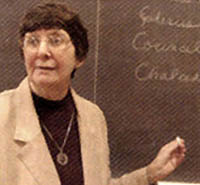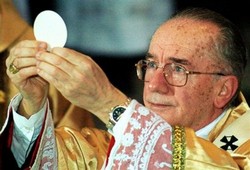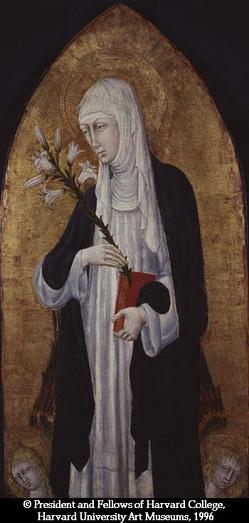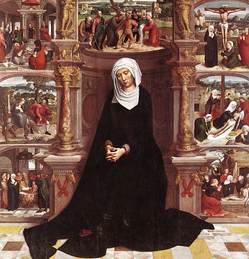 Everyone ought to have a “Saint Monica” figure in their lives. The sainted mother of Saint Augustine is the patron of spiritual maternity. Even though Monica was the biological mother of Augustine, she worked hard in the spiritual realm to get her son to give himself to Christ and his plan rather than his own plan of self-destructive behavior. Her constant prayer, fasting and good works all contributed to Augustine’s conversion. The collect for today’s Mass speaks volumes.
Everyone ought to have a “Saint Monica” figure in their lives. The sainted mother of Saint Augustine is the patron of spiritual maternity. Even though Monica was the biological mother of Augustine, she worked hard in the spiritual realm to get her son to give himself to Christ and his plan rather than his own plan of self-destructive behavior. Her constant prayer, fasting and good works all contributed to Augustine’s conversion. The collect for today’s Mass speaks volumes.
Tag: spiritual maternity
Saint Catherine of Siena: ambassador, woman of holiness & spiritual mother
Pope Benedict spoke in his General Audience today of the great 14th century Dominican sister, Saint Catherine of Siena, holy woman, ambassador, truth-speaker, Doctor of the Church and spiritual mother. His choice of saint could not have been better since the presence of many of the new cardinals were in attendance. Rome Reports provides a brief video clip on the papal address.
Today I would
like to speak to you about a woman who has had an eminent role in the history
of the Church. She is St. Catherine of Siena. The century in which she lived —
the 14th — was a troubled time for the life of the Church and for the
whole social fabric in Italy and Europe.
However, even in
the moments of greatest difficulty, the Lord does not cease to bless his
People, raising men and women saints who stir minds and hearts, bringing about
conversion and renewal. Catherine is one of these and still today she speaks to
us and pushes us to walk courageously toward sanctity to be disciples of
the Lord in an ever fuller sense.
Born in Siena in 1347 to a very numerous
family, she died in her native city in 1380. At 16, moved by a vision of St.
Dominic, she entered the Dominican Third Order, in the feminine branch called
the Mantellate. She stayed with her family and confirmed the vow of virginity
she made privately when she was still an adolescent; she dedicated herself to
prayer, penance, and works of charity, above all for the benefit of the sick.
When
her fame for sanctity spread, she became the protagonist in an intense activity
of spiritual counsel, dealing with all categories of persons: nobles and
politicians, artists and ordinary people, consecrated persons, ecclesiastics,
and including Pope Gregory XI, who at that time resided in Avignon and whom
Catherine exhorted energetically and effectively to return to Rome. She
traveled a lot to solicit the interior reform of the Church and to foster peace
between states. For this reason also the Venerable John Paul II declared her
co-patroness of Europe: so that the Old World would never forget its Christian
roots that are at the base of its journey and continue to draw from the Gospel
the fundamental values that ensure justice and concord.
Continue reading Saint Catherine of Siena: ambassador, woman of holiness & spiritual mother
ENDOW: a new Feminism Catholic style
 ENDOW (Educating on the Nature & Dignity of Women) is a Catholic educational program bringing women together to discover what it means to be a woman, made in God’s image and likeness holding a God-given dignity known in being a person. ENDOW is a new feminism promoting the beauty of being a woman.
ENDOW (Educating on the Nature & Dignity of Women) is a Catholic educational program bringing women together to discover what it means to be a woman, made in God’s image and likeness holding a God-given dignity known in being a person. ENDOW is a new feminism promoting the beauty of being a woman.
John Paul II and the Development of a “New Feminism”
 The April 2010 issue of Inside the Vatican (18:4) published a special commemorative issue observing the papal death of John Paul II and the papal election of Benedict XVI. The editor asked various people to write their memories of one of the popes. Sister Sara Butler, MSBT, a professor of dogmatic theology at St Joseph’s Seminary -Dunwoodie, New York, offered her thoughts on Pope John Paul’s contribution to feminist thinking. Sister Sara is a published author and a member of the Anglican-Roman Catholic Dialogue and the International Theological Commission. Sister remembers:
The April 2010 issue of Inside the Vatican (18:4) published a special commemorative issue observing the papal death of John Paul II and the papal election of Benedict XVI. The editor asked various people to write their memories of one of the popes. Sister Sara Butler, MSBT, a professor of dogmatic theology at St Joseph’s Seminary -Dunwoodie, New York, offered her thoughts on Pope John Paul’s contribution to feminist thinking. Sister Sara is a published author and a member of the Anglican-Roman Catholic Dialogue and the International Theological Commission. Sister remembers:
Looking back over the papacy of the Servant of God John Paul II, I find myself especially grateful for the initiative he took in addressing the feminist critique. The Pope did this in his Letter to Women (1995), his apostolic letter On the Dignity and Vocation of Women (Mulieris dignitatem, 1988), and his ground-breaking catecheses on the “theology of the body.” He not only acknowledged the positive contributions of feminist scholarship and offered needed clarifications and correctives in response to their objections; he also spelled out his own appreciation of the “genius” of women and took steps to promote their increased participation in the Church and in the social order. Since the Pope’s death, we are already beginning to see the fruits of his recommendation that Catholic women undertake to develop a “new feminism,” consistent with Catholic doctrine (Evangelium vitae, par 99). In my opinion , it is hard to overestimate the contribution Pope John Paul II made to meeting this contemporary challenge.
Spiritual Maternity in Saint Catherine of Siena
‘Finish Your Life on the Cross’: Spiritual Motherhood in Saint Catherine of Siena’s Letters to Priests” by Sister Gabriella Yi, O.P was published in L’Osservatore Romano (August 12th-19th English edition). The author, Sister Gabriella Yi, O.P., is a member of the Congregation of St. Cecilia in Nashville, TN (also known as the Nashville Dominicans). A few times in the past I have posted some items on spiritual maternity and its necessity in the Church today, especially in the life of the priest.
At the foot of the cross, in the heart of the redemption, Our Lord Jesus Christ instituted a “new motherhood of Mary,” as he entrusted his mother to his beloved disciple and his beloved disciple to his mother. From this entrustment flows Our Lady’s spiritual motherhood of each member of Christ’s body, the Church, and especially her motherhood of his priests. Her maternal care for each priest was brought to our attention in a particular way by the Congregation for the Clergy’s teaching that, in union with Mary, all women are invited to live out their vocation to spiritual motherhood by offering their prayers and sacrifices for the salvation of souls and the holiness of Christ’s priests.
In his 1988 apostolic letter, Mulieris Dignitatem, Pope John Paul II speaks of motherhood and virginity as two important and related dimensions of a woman’s vocation. He describes how the vocation to motherhood is inscribed in the very being of a woman: she is not only physically but also psychologically endowed with the capacity to create a space within herself for another human being. John Paul speaks of this as a special “entrustment” that God has made to woman; she has the beautiful privilege of bringing forth new life into the world by the generous use of her feminine gifts.
Even those called to a life of consecrated virginity are not excluded from this vocation to motherhood. For them, John Paul says, there is the possibility of “a different kind of motherhood: a motherhood ‘according to the Spirit’. “In the life of consecrated women, this motherhood “can express itself as concern for people, especially the most needy….” John Paul is careful to point out that this concern for others on the part of consecrated women is motivated by spousal love for Christ. Just as natural motherhood is the fruit of the spousal love in marriage between husband and wife, spiritual motherhood is the fruit of the spousal love in religious life between the consecrated virgin and Christ.
What may come as a surprise to some is John Paul’s insistence that spiritual motherhood is not limited to unmarried women: “And does not physical motherhood also have to be a spiritual motherhood, in order to respond to the whole truth about the human being who is a unity of body and spirit?” John Paul II evidently sees it as an important dimension of every woman’s vocation.
The doctor of the Church who most clearly articulates this vocation to spiritual motherhood is the 14th century Dominican tertiary Saint Catherine of Siena, who is perhaps best known for the prayers, sacrifices, and counsel she offered Pope Gregory XI in his decision to return the papacy from Avignon to Rome. In looking to her as a model of spiritual motherhood for priests, we discover that Catherine teaches not only by the example of her prayers and sacrifices, but also by the counsel she offers in her letters: “See that in everything you turn to Mary as you embrace the cross,” “Make your home in the pulpit of the cross,” and “Finish your life on the cross,” encouraging her spiritual sons to identify themselves ever more closely with Christ the High Priest. Catherine’s spiritual motherhood, as seen in these letters, offers us a rich source of inspiration as we enter into this “Year for Priests.”
Catherine’s letters to priests often include words of encouragement in times of difficulty, as she writes to Blessed Raymond of Capua, referring to herself in the third person: “I’ve heard from a servant of God who constantly holds you before God in prayer, that you have been experiencing tremendous struggles and that your spirit has been overtaken by darkness because of the devil’s illusions and deceits.” With this image of holding a soul before God in prayer, as a mother holding her child out so that its Father might take it up into his arms, Catherine reveals the maternal quality of her prayer. With a mother’s intuition illumined by the Holy Spirit, she perceives the spiritual darkness he has fallen into and explains the enemy’s tactics: “He wants to make you see the crooked as straight and the straight as crooked, and he does this to make you stumble along the way so you won’t reach your goal.” In the face of such diabolical attempts to impede his priestly ministry, Catherine assures Raymond, “But take heart. God has provided and will continue to provide for you, and his providence will not fail you.” A priest’s confidence is to be placed, not in himself, where it is sure to fail, but in God’s providential care for him, especially in the form of his mother. As Our Lady’s maternal love for her son embraced him from the moment of his Incarnation to his death on the cross, so, too, does her maternal love embrace his priests in her constant intercession for them. Thus, they can entrust their priestly hearts wholly to hers, especially in times of discouragement, as Catherine advises, “See that in everything you turn to Mary as you embrace the cross.”
But it is not enough to embrace the cross-it must be mounted, as Catherine explains in her letter to Frate Bartolomeo Dominici: “After the fire of the Holy Spirit had descended on [the disciples], they mounted the pulpit of the blazing cross, where they felt and tasted the hunger of God’s Son, his love for humankind.” With this striking image, Catherine expresses the complete identification of Christ and his priests on the cross, blazing with the fire of divine charity, where they feel what he felt and taste what he tasted in his all-consuming love for us. Only from such a pulpit of divine charity do the words of priests wield supernatural power: “Then their words came forth as does a red-hot knife from a furnace, and with its heat they pierced their listeners to the heart and cast out the devils.” Indeed, many of Catherine’s own listeners were pierced to the heart, not only by her words, but also by those of the priests to whom she sent them in the pulpit of the confessional. Whether he is casting out devils in the confessional or at the altar, the pulpit of the cross is where the priest of Christ belongs, as Catherine implores, “So, my dearest son, I beg you-it is my will in Christ Jesus-make your home in the pulpit of the cross.”
From this pulpit, a priest of Jesus Christ engages in a battle for souls, beginning with his own, which is why in her letter to Frate Ranieri Catherine urges, “I long to see you a real knight, fighting against every vice and temptation for Christ crucified with a true holy perseverance.” With such chivalric imagery, she appeals to his masculine instincts for battle and adventure, as she continues, “For it is perseverance that is crowned. You know that victory is achieved by fighting and perseverance. In this life we are set as on a battlefield and we must fight courageously, not dodging the blows or retreating, but keeping our eyes on our captain, Christ crucified, who always persevered.” Just as no soldier goes into battle at his own initiative, but solely at that of his captain, so too must a priest take his commands from Christ, who:
. . . didn’t give up when the Jews said, ‘Come down from the cross!’ Nor did the devil or our ingratitude make him give up fulfilling the Father’s command and our salvation. No, he persevered right up to the end, when he returned to the eternal Father with the victory he had achieved, the victory of having rescued humankind from darkness and given us the light of grace once again by conquering the devil and the world with all its pleasures. And it killed him: this Lamb took death for himself in order to give us life; by his dying he destroyed our death.
Finally, as no soldier dies for an abstraction he holds, but for a beauty he loves, so too must Christ’s priests live and die for love of the beauty of his bride, the Church. Hence, Catherine concludes her letter to this priest simply with, “Finish your life on the cross.”
In these letters to Blessed Raymond of Capua and other priests, the voice of Saint Catherine of Siena as a spiritual mother is unmistakable. The authority with which she speaks is that of one whose spousal love for Christ united her so closely to him that his desire for the salvation of souls and the holiness of his priests has become her very own. As Catherine joins “that gentle mother Mary” in interceding for Christ’s priests, she invites us to do the same. In light of the Congregation for the Clergy’s document calling for spiritual mothers for priests and Pope Benedict XVI’s dedication of the current year as a “Year for Priests,” a rediscovery of this spiritual mother’s letters to priests could not be more timely.
Spiritual Motherhood for Priests takes off
Since last year I’ve been thinking of the role spiritual
mothers, in the example of Our Lady, play in the lives of Catholic priests. I am thinking in particular of Our Lady of Sorrows for this type of spiritual maternity. In the past I mentioned this idea here and here at the beginning of 2009 (perhaps I should do it more). The
call to be a priest’s spiritual mother includes a woman’s offering herself to
God, praying in intercession and reparation for the priest, spending time in
Eucharistic Adoration and becoming a point for God’s grace to work in the life
of a priest. A woman of any age can do this work of intercession; she can be single, married, or widowed. This spiritual work is hidden and contemplative, sacrificial and
silent. It is in this special work that the reparation for the sins of priests
might happen for as the Holy Father said, “nothing makes the Church, the Body
of Christ, suffer more than the sins of her pastors.”
My interest has been sparked by two people, Franciscan
Cardinal Claudio Hummes and Benedictine Father Mark Kirby, the latter drawing
on
Adoration & Spiritual Maternity.pdf to ask the Divine Majesty to renew priesthood
through a special devotion to the Eucharist. But there’s been other work done by
people such as Catherine Dougherty, Mother Marie des Douleurs and Maria Sieler as well as the countless laity and consecrated men and women of the Church.
In October 2008 Tulsa, OK, Bishop Edward Slattery started a
process of formation for women to dedicate their prayer for the needs of the
priesthood. I am told that there are some women in the Bridgeport Diocese that there
are women who dedicate their lives as a spiritual mother for priests but they
are so hidden no one knows them. Something has to be done in the manner in
which Bishop Slattery is doing this holy work!
More recently Jane, living in France, has begun some work
and prayer on spiritual maternity for priests. Her blog, Spiritual Mothers of
Priests, is a good personal initiative to assist priests (and I presume
seminarians) with prayer and sacrifice during this Year of the Priest. Ladies,
visit and follow the work of Jane and join other women to this special work for
priests.
Spiritual Maternity for Priests
In early February, I mentioned the notion, the desire, perhaps even the ministry women can do for the spiritual wellbeing of priests. It is an idea that is growing in the Church and yet its importance is not being recognized by many bishops. However, Bishop Edward Slattery, bishop of Tulsa, inaugurated a work of spiritual maternity for priests in the Tulsa diocese on March 24th. The good part of this work is the on-going formation. Father Mark Kirby writes about it on his blog.
Pope Benedict XVI speaks at the monastery of the Benedictine Oblate Sisters of St. Frances of Rome, Tor de’ Specchi
This is a rather important talk Pope Benedict XVI gave while visiting the Oblates of Saint Frances of Rome. Every pope since the 16th century has visited this monastery. Pope John Paul was the last 25 years ago.
Dear Oblate Sisters,
 After my visit to the nearby Municipal Hall on the Capitoline Hill, I come with great joy to meet you at this historic Monastery of Santa Francesca Romana, while you are still celebrating the fourth centenary of her canonization on 29 May 1608. Moreover, the Feast of this great Saint occurs this very day, commemorating the date of her birth in Heaven. I am therefore particularly grateful to the Lord to be able to pay this tribute to the “most Roman of women Saints”, in felicitous continuity with the meeting I have just had with the Administrators at the municipal headquarters. As I address my cordial greeting to your community, and in particular to the President, Mother Maria Camilla Rea whom I thank for her courteous words expressing your common sentiments I also extend my greeting to Auxiliary Bishop Ernesto Mandara, to the students who live here and to everyone present.
After my visit to the nearby Municipal Hall on the Capitoline Hill, I come with great joy to meet you at this historic Monastery of Santa Francesca Romana, while you are still celebrating the fourth centenary of her canonization on 29 May 1608. Moreover, the Feast of this great Saint occurs this very day, commemorating the date of her birth in Heaven. I am therefore particularly grateful to the Lord to be able to pay this tribute to the “most Roman of women Saints”, in felicitous continuity with the meeting I have just had with the Administrators at the municipal headquarters. As I address my cordial greeting to your community, and in particular to the President, Mother Maria Camilla Rea whom I thank for her courteous words expressing your common sentiments I also extend my greeting to Auxiliary Bishop Ernesto Mandara, to the students who live here and to everyone present.
As you know, together with my collaborators in the Roman Curia, I have just completed the Spiritual Exercises which coincided with the first week of Lent. In these days I have experienced once again how indispensable silence and prayer are. And I also thought of St
Your monastery is located in the heart of the city. How is it possible not to see in this, as it were, the symbol of the need to bring the spiritual dimension back to the centre of civil coexistence, to give full meaning to the many activities of the human being? Precisely in this perspective your community, together with all other communities of contemplative life, is called to be a sort of spiritual “lung” of society, so that all that is to be done, all that happens in a city, does not lack a spiritual “breath”, the reference to God and his saving plan. This is the service that is carried out in particular by monasteries, places of silence and meditation on the divine word, places where there is constant concern to keep the earth open to Heaven. Then your monastery has its own special feature which naturally reflects the charism of St
 In our day too, Rome needs women and of course also men but here I wish to emphasize the feminine dimension women, as I was saying, who belong wholly to God and wholly to their neighbour; women who are capable of recollection and of generous and discreet service; women who know how to obey their Pastors but also how to support them and encourage them with their suggestions, developed in conversation with Christ and in first-hand experience in the area of charity, assistance to the sick, to the marginalized, to minors in difficulty. This is the gift of a motherhood that is one with religious self-gift, after the model of Mary Most Holy. Let us think of the mystery of the Visitation. Immediately after conceiving the Word of God in her heart and in her flesh, Mary set out to go and help her elderly kinswoman Elizabeth. Mary’s heart is the cloister where the Word continues to speak in silence, and at the same time it is the crucible of a charity that is conducive to courageous gestures, as well as to a persevering and hidden sharing.
In our day too, Rome needs women and of course also men but here I wish to emphasize the feminine dimension women, as I was saying, who belong wholly to God and wholly to their neighbour; women who are capable of recollection and of generous and discreet service; women who know how to obey their Pastors but also how to support them and encourage them with their suggestions, developed in conversation with Christ and in first-hand experience in the area of charity, assistance to the sick, to the marginalized, to minors in difficulty. This is the gift of a motherhood that is one with religious self-gift, after the model of Mary Most Holy. Let us think of the mystery of the Visitation. Immediately after conceiving the Word of God in her heart and in her flesh, Mary set out to go and help her elderly kinswoman Elizabeth. Mary’s heart is the cloister where the Word continues to speak in silence, and at the same time it is the crucible of a charity that is conducive to courageous gestures, as well as to a persevering and hidden sharing.
Dear Sisters, thank you for the prayers with which you always accompany the ministry of the Successor of Peter and thank you for your invaluable presence in the heart of
Spiritual maternity for priests
Do you ever think of the connection between holiness and priests? I am NOT suggesting a vague academic consideration of the topic but I am wondering about it in the concrete. Every now and again the notion –perhaps I can even say vocation– of spiritual paternity and maternity arises in me and I am not exactly sure where the idea comes from or where it is going. The matter of the holiness of priests –indeed, of all people, concerns me, but right now I am thinking specifically of the ordained’s holiness because it is a real need in our ecclesial life together today.
Friends, laity and clergy alike who work as spiritual fathers and mothers, live a beautiful vocation in walking spiritually with those who are ordained. They become familiar with the personal narratives of sin and grace, they hear about the presence of the Lord in daily living, and they know the struggles of faith, hope and charity. In a word, spiritual fathers and mothers see the reality of Divine intimacy at work.
So, let me say a very brief word about the idea of spiritual maternity for priests. Actually, let me point you in the direction of the spiritual maternity of Catherine Doherty, a well known mystic of the 20th century who had a special love for the priesthood and the enduring need of priests to be holy. Doherty said once, “I wish I could tell every priest that I share his pain and joy, whatever it may be, because I love the priesthood passionately.” But there are others as Cardinal Hummes indicates in a recent letter (see below), who have been called to this vocation.
What I am interested is real holiness, not fake spiritual sentimentality, not some vague “connection” with the divinity. Rather, holiness is a way of life centered on reality as it is given and lived in the light and tension of the Gospel, the sacraments and the Church.
Having  concern for priests, Claudio Cardinal Hummes wrote in 2007 to the world’s bishops asking for help in establishing in their dioceses places of eucharistic adoration and the development of a spiritual work that looks to women to assist in flourishing of holiness in the priesthood. That letter bears greater attention and so I have linked it here.
concern for priests, Claudio Cardinal Hummes wrote in 2007 to the world’s bishops asking for help in establishing in their dioceses places of eucharistic adoration and the development of a spiritual work that looks to women to assist in flourishing of holiness in the priesthood. That letter bears greater attention and so I have linked it here.
Cardinal Hummes says many memorable things in his letter on spiritual maternity but important item that needs to rememmbered is the following:
According to the constant content of Sacred Tradition, the mystery and reality of the Church cannot be reduced to the hierarchical structure, the liturgy, the sacraments, and juridical ordinances. In fact, the intimate nature of the Church and the origin of its sanctifying efficacy must be found first in a mystical union with Christ.
For more information read my friend Father Mark’s recent essay on the subject.


